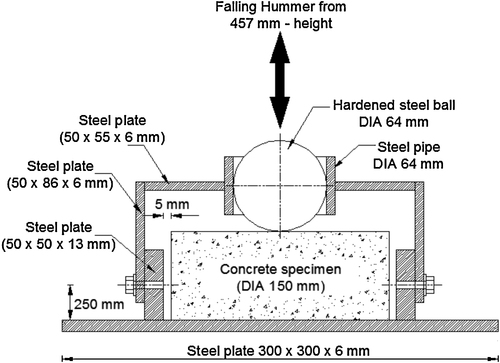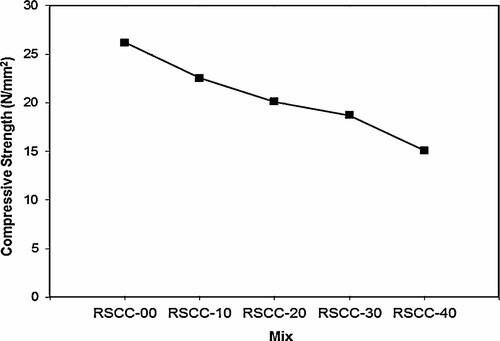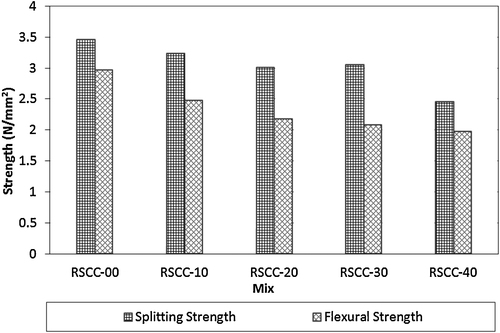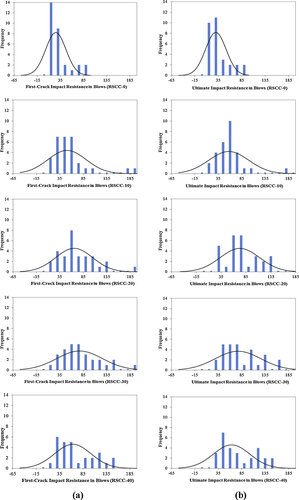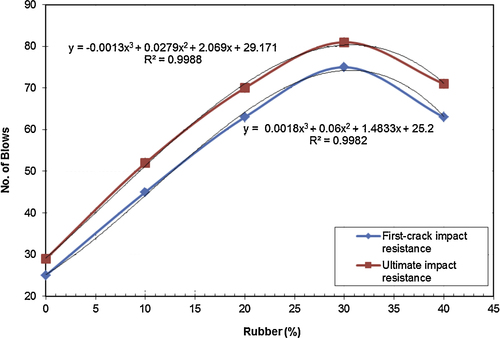Abstract
Impact loads due to ship collision on irrigation structures is significantly decreasing their durability. Loss of material and degradation are quite common problems facing lock walls and piers. In the current research, rubberized self-compacting concrete (SCC) was used to investigate problems associated with impact. SCC with cement kiln dust cement replacement was used for that purpose. Concrete specimens were prepared with different crumb rubber ratios of 10% (RSCC-10), 20% (RSCC-20), 30% (RSCC-30), and 40% (RSCC-40) sand replacement by volume. Standard compressive, flexure, and splitting strength tests were conducted to monitor the effect of the added rubber on concrete behavior. Moreover, impact testing program was applied to specific specimens, cylinder of diameter 200 mm and thickness 50 mm, according to ACI committee 544 procedures. The number of blows to first and ultimate cracks was determined. The relationship between the mechanical properties and impact resilience is also presented. With the increase in rubber percentage the resistance to impact increased, but there was a decrease in specimen strength and modulus of elasticity. The variation in results was discussed and mix RSCC-30 exhibited the best impact resistance, 3 times over control mix with 40% reduction of compressive strength.
1 Introduction
Self-compacting concrete (SCC) has widely been used in many concrete structures of massive or irregular geometry. SCC is known for its excellent deformability, high resistance to segregation, and successful use in congested reinforced concrete structures characterized by difficult casting conditions that do not allow for vibration (CitationGüneyisi, 2010). In the current research, Rubberized SCC incorporated cement kiln dust was examined for impact resistance. The current work presented dual beneficiary to produce economic ductile concrete. Recently, the durability of concrete can be achieved using environmental friendly wastes or industrial by-products (CitationDay, 1999; CitationTopçu and Bilir, 2007, Citation2009; CitationTopçu et al., 2008; CitationYuksel et al., 2007). CitationOkamura and Ouchi (1998) added that the concrete industry can succeed in creating durable and reliable concrete structures with very little maintenance when SCC becomes widely used. Moreover, implementing Fly Ash (FA), limestone powder, marble dust, cement kiln dust, etc. as filler material or partially in powder material improves the durability of SCC (CitationDay, 1999).
On the other hand, waste tires are dramatically creating significant environmental, health, and esthetic issues, posing a key management problem without an easy solution. Using waste tires in concrete production is one possible disposal option, but more potential solutions to this problem are still needed (CitationKhaloo et al., 2008; CitationSavas et al., 1997). The purpose of aggregating rubber is to increase concrete's flexibility, elasticity, and capacity to absorb energy. Many researchers have therefore used rubber particles as aggregates in concrete production to eliminate poor deformation capacity, low tensile strength, and improve energy absorption capacity (CitationOzbay et al., 2011). Results from previous tests indicated that introducing rubber particles as aggregate enhanced deformation and energy absorption capacities while they decreased workability and mechanical properties (CitationEldin and Senouci, 1993; CitationKhatip and Bayomy, 1999; CitationTopçu, 1995). Few studies have produced rubberized self-compacting concrete (RSCC) to diminish the negative effect of rubber aggregate on concrete workability. Although the effects of rubber aggregate content on the fresh and mechanical properties of RSCC have been studied in several studies (CitationBignozzi and Sandrolini, 2006; CitationGüneyisi, 2010; CitationNajim and Hall, 2010; CitationTopçu and Bilir, 2009; CitationTuratsinize and Garros, 2008), there is still a dearth of data on its impact resistance, transport and durability properties. CitationTopçu and Demir (2007) investigated durability properties of rubberized concrete and mortar, under the effect of freezing and thawing, seawater, and high temperature effects. They concluded that 10% rubber aggregate in volume is the optimum amount to produce economical and sufficient durable RSCC. Additionally, vehicle impacts taking place with rubberized concrete barriers have been approached as a solution for collision problems (CitationTopçu and Avcular, 1997).
Generally, several impact tests have been used to demonstrate the relative brittleness and impact resistance of concrete and similar construction materials (CitationBarr and Baghli, 1988; CitationKishi et al., 2002; CitationMindess and Cheng, 1993; CitationOng et al., 1999). However, none of these tests has been declared to be a standard test, at least in part due to the lack of statistical data on the variation of the results. In this regard, CitationACI Committee 544 (1996) proposed a drop-weight impact test to evaluate the impact resistance of fiber concrete. The test is widely used since it is simple and economical. However, the results obtained from this test are often noticeably scattered.
This aim of this study was to provide an in sight on the effect of rubber as a partial replacement of sand on the mechanical properties and impact resistance of self-compacting concrete (SCC). The SCC included cement kiln dust as partial replacement of cement to improve workability. Four different volume ratios of crumb rubber (10%, 20%, 30%, and 40%) were used as a partial replacement of the sand. According to the results of the experiments, it was determined that the addition of rubber aggregate into concrete does in fact increase its impact resistance. It was also noticed that the impact increase was proportional with the added amount of rubber. This resistance was derived from the increased ability of rubberized concrete to absorb energy safely, and insulate sound waves during impact. The aggregated rubber allowed the concrete to express high flexibility and capacity to resist strokes. This increase in elasticity and ability to absorb energy greatly reduced the damage incurred by colliding objects.
2 Experimental work
2.1 Material and methods
All test specimens were fabricated using locally available materials. Type (I) ordinary Portland cement was utilized. Cement kiln dust (CKD) was used as a partial replacement of cement. The sand used was local natural siliceous sand with specific gravity of 2.60 and finance modulus of 2.34. The coarse aggregate used was natural gravel with maximum aggregate size of 20 mm and specific gravity of 2.55. Super plasticizer, as a high range water reducer without retarding, was used. Super plasticizer was used as a demand for producing SCC. Crumb rubber with a maximum size of 2 mms was used as a partial replacement of sand by volume. In this study, four different volume ratios of crumb rubber, 10% (RSCC-10), 20% (RSCC-20), 30% (RSCC-30), and 40% (RSCC-40), were used in replacement of sand. In addition, a concrete mix with no rubber was used as a control (RSCC-0), . Mixing was carried out in three stages; dry mix for 1 min, wet mix for 2 min, addition of SP, and a final mix for not less than 2 min. Subsequently, the fresh properties of RSCC mixes. Flowability and Passing-ability tests were determined. Concrete specimens were cast in standard steel molds. Cubes 150 mm × 150 mm × 150 mm were prepared to be tested under static compression. The obtained stress strain curves were then used to obtain the static modulus of elasticity. Indirect tensile test was applied on cylinders of 150 mm diameter and 300 mm height (CitationASTM C496, 2010). Prisms of 100 mm × 100 mm × 500 mm were prepared for Four Points Loading Flexure Test (CitationASTM C78, 2010). Discs of 150 mm diameter and 63 mm height were prepared to be tested under impact compression according to ACI Committee 544 “Repeated Drop-Weight Impact Test” (1996). After 24 h from mixing, all the specimens were de-molded and cured in water tank for 28 days.
Table 1 Mix proportions of concrete mixes.
2.2 Impact test setup
Self-made impact instrument was fabricated according to the current recommendations of ACI Committee 544. The test was carried out by dropping a hammer weighing 44.7 N freely from a height of 457 mm repeatedly. The hammer was dropped on a 63.5 mm-diameter hardened steel ball that was placed on the center of the upper face of 150 mm × 63.5 mm cylindrical concrete specimen (disk), as shown in . The steel ball was free to move vertically within a cylindrical sleeve. For each specimen, the number of blows corresponding to initial and ultimate failure was recorded. The first number was identified by the appearance of the first visible hair crack denoted by first-crack impact resistance (FC). The test was continued until complete failure where sufficient impact energy was applied to spread the cracks until specimen parts are moved to touch the steel lugs – 5 mm away from specimen circumference. The ultimate impact resistance (UR) was then represented by the total number of blows required to propagate cracks until ultimate failure.
3 Results and discussion
3.1 Fresh properties
The standard slump test (Flowability) was carried out according to the CitationEuropean Guidelines (2005) for SCC-2005. The test showed slight differences with the increase of rubber volume in all mixes. The Flowability was decreased 11.5%, from 650 mm to 575 mm, for mixes with no rubber to mixes with 40% rubber replacement, respectively, (). The results of the L-box test have shown similar effect with the increase in the rubber content. For the 40% rubber content replacement, the mix was less able to pass by about 13.1% with respect to that of the case of the mix with no rubber.
Table 2 Concrete fresh properties.
3.2 Hardened properties
3.2.1 Compressive strength
The compressive strength showed considerable decrease with the increase in rubber content. A reduction of about 40% was observed from 0% to 40% rubber content sand replacement. To maintain the compressive strength requirements for such concrete type, the mix design has to be adjusted for such strength loss. The compression stress–strain distribution varies according to the rubber content as shown in . The strain energy is reduced as the percentage of the rubber increases. Most of the mixes would fail at the same strain value except for the large rubber replacement value of 40%. There is a slight increase in the modulus of compression elasticity for the minor rubber contents. After such slight increase, the modulus of elasticity decreases as the rubber content increases, similar to the reduction in compressive strength in relation to the rubber content. shows the reduction in the compressive strength values for the rubberized concrete mixes.
3.2.2 Indirect tensile strength
The splitting tensile strength was conducted as per CitationASTM C496 (2010). The test showed considerable decrease in the indirect strength with the increase in rubber content. The recorded split tensile test was on the average of 8.75% with respect to the compressive strength of the studied mixes.
3.2.3 Flexural tensile strength
The flexural tensile strength for 100 mm × 100 mm × 500 mm prismatic specimens showed considerable decrease with the increase in rubber content, in nearly a linear relation and slightly less than that of the split tensile test. A reduction of about 29% was observed from 0% to 40% rubber content. The recorded flexural tensile test results were on the average of 6.71% with respect to the compressive strength of the studied mixes. A summary for the splitting and flexure strength is shown in .
3.3 Impact resistance
The first crack strength is associated with the first signs of deterioration under impact loading. The first crack appears in a radial direction from the center of the circular specimens. The results showed wide range of FC that vary from a specimen to another for the same mix which agree with many past researches (CitationBadr et al., 2006). The Ultimate impact resistance followed the same trend of FC. When sorting the data, it seems that the higher the rubber content, the higher ability to resist more blows and thus, the higher tendency to absorb energy. and shows two columns’ plots for the normal distribution density function for all examined specimens for both FC and UR, respectively. The frequency of occurrence of group of cracks stepped to an interval of 15 cracks was also represented on these graphs. It has been noticed a narrow range of diversion for RSCC-0. Consequently, the probability of the specimens to be cracked for both FC and UR with relatively low number of blows was higher than all specimens of other mixes containing rubber. It was also noticed that the distribution for rubberized concrete was widely spread showing large range of blows. The source of variation in getting the impact resistance of concrete is that the ACI test is based on a single point of impact, which might happen to be on a hard particle of coarse aggregate or on a soft area of mortar.
The above graphs also showed that RSCC-30 exhibited the best distribution among all examined specimens. Moreover, the average number of blows required for both FC and UR were plotted and shown in . The difference between the average number of blows for FC and UR were 4, 7, 7, 6, and 8 for RSCC-0, RSCC-10, RSCC-20, RSCC-30, and RSCC-40, respectively. The peak of both curves occurred at 30% rubber replacement value. It is also noticed that RSCC-30 reached approximately 3 times the number of blows exerted by RSCC-0. It could also be concluded that higher rubber replacement to sand, over 30%, effect greatly the interlocking between aggregates leading to loss of its mechanical properties that counterpart the improvement in impact resistance.
shows the mean, standard deviation, and coefficient of variance for all examined specimens. It is noticeable that despite the fact that the average number of blows increased slightly from the first crack to the ultimate strength, the standard deviation did not very much. Unlike compressive strength, it is not realistic to use the standard deviation to judge or compare the impact resistance results, and it is more appropriate to use the coefficient of variation. The coefficient of variation is considered a more meaningful index of variability because it accounts for the mean as well as the standard deviation. CitationDay (1999) stated that several ACI committees including 212 (mixture proportioning), 214 (evaluation of test results) and 363 (high strength concrete) have adopted the coefficient of variation as a measure of variability rather than the standard deviation.
Table 3 Statistical parameters for blow numbers for each mix.
4 Conclusion and recommendation
Rubberized concrete show some promising behavior against impact loading. The main disadvantage is that the increase in rubber content reduces the compressive strength of such mixes with respect to concrete mixes with no rubber content. It is highly recommended to expand such scope of work to cover a variety of construction material used in structures subjected to impact loading. The durability aspects would be an important factor to study for this material under various loading conditions.
This type of loading, its contribution to the internal stresses and the necessary protection must be studied on various types of structures. Ordinary structures that are subjected to impact load maybe buildings in hurricane and typhoon regions or important residential buildings such as hospitals. Special structures such as power stations, navigation locks are prone for such frequent and continuous impact for a number of reasons. Floating debris entering pump stations intakes, wondering ships and barges are considered one of the major sources of impact stresses for such structures. Bridges, harbors, jetties and protection dikes are a group of structures that are constantly prone to such loading with known cases of failure.
Conflict of interest
The authors declare no conflict of interest.
Acknowledgement
The authors wish to thank the Construction Research Institute, National Water Research Center for providing the assistance to complete this study.
Notes
Peer review under responsibility of National Water Research Center.
References
- ACI Committee 544. ACI 544.2R-89Measurement of properties of fibre reinforced concreteACI Manual of Concrete Practice, Part 5: Masonry, Precast Concrete and Special Processes1996American Concrete Institute
- ASTM C78/C78 M-10Standard Test Method for Flexural Strength of Concrete (Using Simple Beam with Third-Point Loading)2010
- ASTM C496/C496 M-04Standard Test Method for Splitting Tensile Strength of Cylindrical Concrete Specimen2010
- A.BadrA.AshourA.PlattenStatistical variations in impact resistance of polypropylene fibre-reinforced concreteInt. J. Impact Eng.32200619071920
- BarrA.BaghliA repeated drop-weight impact testing apparatus for concreteMagn. Concr. Res.401441988167176
- M.C.BignozziF.SandroliniTire rubber waste recycling in self-compacting concreteCem. Concr. Res.362006735739
- K.W.DayConcrete Mix Design, Quality Control and Specification2nd ed.1999E&FN SponLondon
- N.EldinA.B.SenouciRubber tire particles as concrete aggregateJ. Mater. Civil Eng. ASCE51993478496
- European Self-Compacted Concrete GroupThe European Guidelines for Self-Compacting Concrete. Specification, Production and Use2005BIBM, CEMBUREAU, ERMCO, EFCA, and EFNARC
- E.GüneyisiFresh properties of self-compacting rubberized concrete incorporated with fly ashMater. Struct.43201010371048
- A.R.KhalooM.DehestaniP.RahmatabadiMechanical properties of concrete containing a high volume of tire-rubber particlesWaste Manage.28200824722482
- Z.K.KhatipF.M.BayomyRubberized Portland cement concreteJ. Mater. Civil Eng. ASCE111999206213
- N.KishiH.KonnoK.IkedaK.G.MatsuokaPrototype impact tests on ultimate impact resistance of PC rock shedsInt. J. Impact Eng.2792002969985
- S.MindessY.ChengPerforation of plain and fibre reinforced concretes subjected to low-velocity impact loadingCem. Concr. Res.23119938392
- K.B.NajimM.R.HallA review of the fresh/hardened properties and applications for plain-(PRC) and self-compacting rubberized concrete (SCRC)Constr. Build. Mater.24201020432051
- H.OkamuraM.OuchiSelf-compacting high performance concreteProg. Struct. Eng. Mater.41998378383
- K.C.G.OngM.BasheerkhanP.ParamasivamResistance of fiber concrete slabs to low velocity projectile impactCem. Concr. Compos.215–61999391401
- E.OzbayM.LachemiU.K.SevimCompressive strength, abrasion resistance and energy absorption capacity of rubberized concretes with and without slagMater. Struct.447201112971307
- B.Z.SavasS.AhmadD.FedroffFreeze–thaw durability of concrete with ground waste tire rubberTransp. Res. Rec. TRB: Adv. Concr. Concr. Pavement Constr.157419978088
- I.B.TopçuThe properties of rubberized concretesCem. Concr. Res.251995304310
- I.B.TopçuN.AvcularCollision behaviors of rubberized concreteCem. Concr. Res.2712199718931898
- I.B.TopçuT.BilirEffects of slag fineness on durability of mortarsJ. Zheijang Univ. Sci. A8200717251730
- I.B.TopçuT.BilirExperimental investigation of some fresh and hardened properties of rubberized self-compacting concreteMater. Des.30200930563065
- I.B.TopçuA.R.BogaT.BilirAlkali–silica reactions of mortars produced by using waste glass as fine aggregate and admixtures such as fly ash and Li2CO3Waste Manage.282008878884
- I.B.TopçuA.DemirDurability of rubberized mortar and concreteJ. Mater. Civil Eng. ASCE22007173178
- A.TuratsinizeM.GarrosOn the modulus of elasticity and strain capacity of self-compacting concrete incorporating rubber aggregatesResour. Conserv. Recycl.52200812091215
- I.YukselT.BilirO.OzkanDurability of concrete incorporating non-ground blast furnace slag and bottom ash as fine aggregateBuild Environ.42200726512659

